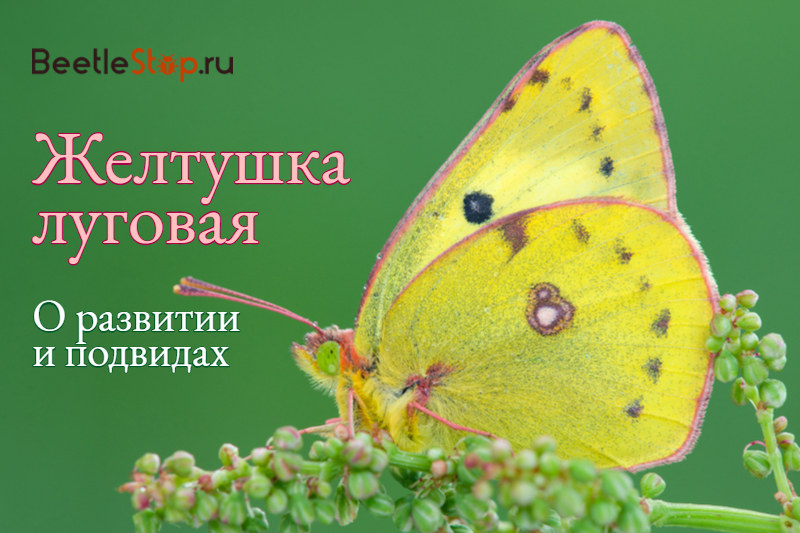Butterfly jaundice meadow - lover of clover and alfalfa
In summer, light-winged butterflies can be seen in the fields of alfalfa or clover. This is meadow jaundice, a representative of a large family of whites. Butterflies are prone to migration; they fly north in search of fodder plants. Insects are found in Europe and the temperate zone of Asia. In connection with various living conditions, several subspecies of meadow jaundice appeared.

View description
Meadow jaundice (Coliashyale) - a butterfly from the genus of jaundice, a family of whites. The view was described by Carl Linnaeus in 1758. The Latin name hyale - came from the name of the Greek nymph Hyala. Synonyms for designation - common jaundice and small peat jaundice.
The butterfly is medium in size, the wingspan is 60 mm, the length of the front wing is in the range of 20-30 mm. The color of the upper side of the male’s wings is light yellow, sometimes with a greenish tint. A grayish coating is at the base. The upper part of the front wing ends in a dark field with blurry yellow spots. Two small black spots are visible in the middle. On the hind wings of the border already, discal spots are orange. The underside is lemon yellow.
The female is lighter, the main background of the wings is whitish, with a slight dusting of yellow scales. The pattern on the wings is the same as that of the male. The shape of the front wings is close to rectangular, the hind wings are rounded. The fringe is pink. The head of the butterflies is round, the eyes are hemispherical. The antennae are club-shaped, pink. They thicken from the base to the top, the club is isolated. All limbs are well developed and are used when walking. The abdomen is thin, sharply tapering to the edge. There are long hairs on the chest.
Habitat
The meadow yaundice butterfly prefers a moderately warm climate. She lives in the middle zone of Europe and Asia. It is found in Turkey. Mongolia, in the north of China, is a frequent visitor to the countries of Eastern Europe. In Russia, a yellow butterfly can be found in the south of Siberia, migrants reach the Polar Urals. Moths live in flowering mountain meadows, climbing to a height of 2000 m.
Interesting fact. In the Caucasus and southern Europe, the twin Coliashyale (jaundice hyala) - Coliasalfacariensis (southern jaundice) is found. Representatives of species can not be distinguished even by entomologists. Adults have a similar color - yellow or light wings with a dark border around the edge. The species can only be identified by the caterpillar. In Coliasalfacariensis, the caterpillars are decorated with longitudinal yellow stripes and rows of black spots.
Sub-classification
Scientists identified 6 subspecies of Coliashyale, depending on the regions of their habitat:
- Coliashyalehyale - nominative European subspecies;
- C. h. novasinensis - north of China;
- C. h. irkutskana - Transbaikal region;
- C. n. altaica - Altai mountains;
- C. n. alta - mountains of the Tien Shan, Pamir, Darvaz;
- C. n. palidis - Eastern Siberia.
Features of reproduction and development
Ordinary jaundices settle in open spaces - glades, meadows, roadsides, wastelands. Two to three generations a year. Adult years in the southern regions are observed from April to September — October. The first generation in temperate regions flies from May to June, the second - from mid-July to the end of August. Butterflies of two generations often fly at the same time.
Adults drink nectar on the colors of clover, clover, broom, found on rosaceous and cruciferous plants.Activity is shown in the daytime. In a resting position, the adults fold their wings behind their backs. The female lays 1-2 eggs on the inner side of the leaves of fodder plants: mouse peas, vetch, alfalfa, clover. The eggs are oval, 1 mm long. Initially, they are white, but before the offspring appear, they change color to bright orange. The embryo develops 7-8 days.
Caterpillar development
Larvae of the first age only 1.6 mm long. The head is large, black, covered with white granules. Caterpillars are slow, they skeletonize foliage. The development of the summer generation takes 10-24 days. Autumn caterpillars leave for wintering after the third molt. By this time, their length is 8 mm, the color is green, the body is finely granulated. In Europe they hibernate, wrapped in leaves, in a harsher climate they hide under the leaf litter, bury themselves in the surface soil layer.
Information. The period of development of wintering caterpillars is up to 8 months.
In the spring, caterpillars complete their development. They grow to 30 mm, the color is green, covered with dark hairs. The longitudinal strip on the sides consists of three colors - white, yellow and reddish spots in the area of the spiracles.
After the fifth age, pupate, attaching to the stem or leaf with a silk belt. Pupa length 20-22 mm, color green. There are several black dots in the wing area. The imminent appearance of a butterfly is signaled by a change in color, the pupa becomes red-yellow.


 (votes: 3, average rating: 4,67 out of 5)
(votes: 3, average rating: 4,67 out of 5)